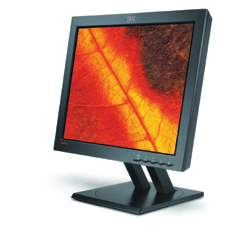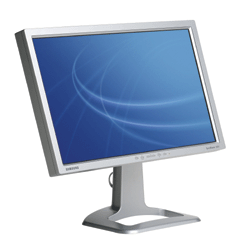Flats Take Flight
Oversized LCDs continue their domination over CRTs.
Latest News
November 1, 2004
By Alan Joch
Columbus was wrong: The world is flat. At least it appears that way due to thecontinuing surge in liquid crystal display (LCD) sales. Enjoying the LCD’s abilityto more accurately display geometric shapes without the head-pounding flicker,engineers are doing their part to promote the rise of LCDs at the expense of theCRT market.
Flat-panel progress has advanced so completely in the last year that LCDs nowcommand about 65 percent of the monitor market with CRTs making up the rest. Thedisparity promises to become even more lopsided in the coming year. “A lot ofcustomers that have been reluctant to shift to LCDs will have to look in thatdirection,” says Scott Gray, product marketing manager for displays at Hewlett-Packard’sPersonal Systems Group in Houston.

The Sony SDM -P234 LCD has a 1920 3 1200 Maximum resolution and a 23-inch screen.

Supply and Demand
And there’s good reason. Engineers looking for 19-inch and larger displays maynot have a choice but to consider LCDs. When Sony stopped manufacturing tube-basedmonitors last year, it left one supplier of aperture-grill CRTs in the market.The sole survivor, Mitsubishi, announced earlier this year that it plans to ceaseaperture-grill CRT production by the middle of 2005. In response, a number ofmonitor makers are turning their full attention to LCDs. Sony and Eizo Nanao Technologiesare no longer actively selling CRTs aimed at engineering applications. Others,including Hewlett-Packard, will sell off existing CRTs, and hint that they won’tintroduce any new tube models in the years ahead.
Hastening the move to flat-panel displays, LCD costs began declining last summerafter supply shortages temporarily spiked prices in the first half of this year.Increased supplies from new production lines and lower than anticipated flat-panelTV sales are contributing to ready inventories of large-screen monitors, vendorssay. The result is that LCDs have never been cheaper. “Prices are about 20 percentlower than a year ago,” says Adam Schmidt, product marketing manager for PlanarSystems Inc. of Beaverton, OR, “and a majority of that decrease has come in thelast couple months. We expect oversupplies to continue for at least the next sixmonths.” That means 19-inch displays, now selling for between $599 and $799, coulddip to around $500 by mid-2005, with 21-inch models dropping from about $1200to less than $1000.
criteria for LCD selection
See the November 2004 Resource Guide Chart “Liquid Crystal View.”
Falling prices may make LCDs more attractive to engineers. But given the numberthat are 19 inches in size and larger, how can designers identify displays capableof handling their high-performance technical applications?
The foremost criterion is resolution. “Each pixel is an opportunity to presentdata,” Schmidt points out. “The more pixels you can pack into a small area, themore opportunities you have to present data.”
Nineteen-inch LCDs, which typicallysupport SXGA (1280 x 1024 pixel) resolution, crowd about 1.3 million pixels ontothe screen real estate. Even denser are models 20 inches and larger, which offersharper UXGA (1600 x 1200 pixel) resolution, or about 1.9 million pixels on screen.Engineers and other technical users are beginning to request a step up in pixelpower, and accordingly, 1920 x 1200 pixel resolutions are starting to appear in23-inch displays. Hewlett-Packard sells an LCD in this category for designerswho need to view large images or open multiple windows and tool bars. IBM is consideringits own 23-inch LCD, but has yet to commit to this market, says Mickey Mantiply,LCD product manager for IBM based in Raleigh, NC. The company already sells a22-inch model with a 3840 x 2400 pixel resolution for specialized engineeringand technical markets, he adds.
Response time is a second important performance criterion for some engineers.For most CAD/CAM duties, the 25ms times typical of large-screen LCDs are adequateand won’t create image ghosting problems. However, engineers who frequently createsimulations or pan and rotate drawings may need the sub-20ms speeds that are morecommon on 19-inch and smaller displays. Over the next year, look for even largerLCDs to become faster.

Samsung SyncMaster 243T has room to spare.
More Applications to Run
ViewSonic is among the monitor vendors that has already addressed the need forspeed. It offers a 19-inch model rated at 12ms and a 20-inch model at 16ms. InNovember, ViewSonic plans to launch a 23-inch LCD also running at 16ms.
Next, engineers should look for LCDs that provide wide viewing angles, the bestbeing 170 degrees or greater. Wide angles make it easier for multiple people toclearly see what’s on a single screen when they’re collaborating. Two types ofcommonly used LCD technologies—vertical alignment and in-plane switching—showdistinct differences in viewing angles. Vertical alignment delivers wider anglesand higher contrast ratios. 
The Eizo line maintains accurate colors.
However, the technology choice isn’t a slam dunk. In-plane switching generallyprovides greater accuracy in representing colors across the entire screen, especiallyaround the edges. “It avoids the major problems that can occur with large-screenLCDs in representing color,” says David Waletzki, VP with Eizo Nanao TechnologiesInc., Allendale, NJ. “There isn’t a color wash out.”
Finally, many engineers run multiple simultaneous applications and need morethan one display on their desks, which is easier to do with flat-panel LCDs. “Peoplecan have many applications running at once—their CAD program, e-mail, a spreadsheet,a Web browser,” says Schmidt. “This makes it easier to cross-reference data withoutthe hassle of constantly opening new screens.”
NEC’s MultiSync displays reach 21 inches in size.
 Work in Progress
Work in Progress
New wide LCDs with aspect ratios of 4:3 offer an alternative to multiple monitors.“In some cases, the wider formats meet the requirements of those who are usingtwo screens,” says Erik Willey, senior product manager for ViewSonic in Walnut,CA. “Previously we had not seen wide adoption ... simply because graphics cardsdidn’t support those formats. Now we’re seeing every major graphics card vendoroffering drivers to support wide-screen displays.”
Monitor makers point out that LCDs are still works in progress, unlike matureCRT technology. “There are still some areas where LCD technology is behind,” saysWilley, adding that in the next year we’ll see improvements, especially in colorsaturation and response time, which should push LCD acceptance to even higherlevels.
Alan Joch is a business and technology writer based in New England. You can offerhim feedback about this article through [email protected].
See the November 2004 Resource Guide Chart “Liquid Crystal View.”
Subscribe to our FREE magazine, FREE email newsletters or both!
Latest News
About the Author
DE’s editors contribute news and new product announcements to Digital Engineering.
Press releases may be sent to them via [email protected].






